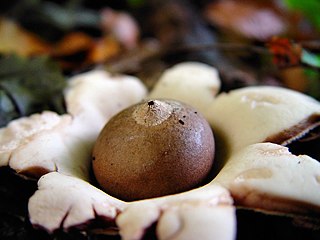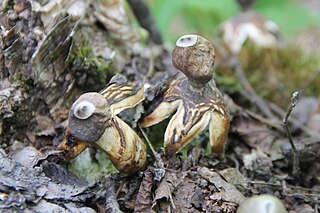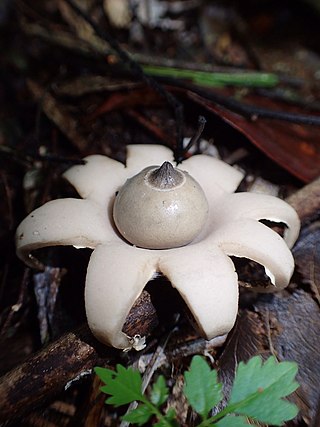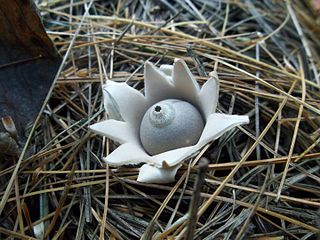
Puffballs are a type of fungus featuring a ball-shaped fruit body that bursts on contact or impact, releasing a cloud of dust-like spores into the surrounding area. Puffballs belong to the division Basidiomycota and encompass several genera, including Calvatia, Calbovista and Lycoperdon. The puffballs were previously treated as a taxonomic group called the Gasteromycetes or Gasteromycetidae, but they are now known to be a polyphyletic assemblage.

Geastrales is an order of gasterocarpic basidiomycetes (fungi) that are related to Cantharellales. The order contains the single family Geastraceae, which includes the "earthstars" formerly placed in Lycoperdales, or Phallales.

Geastrum is a genus of puffball-like mushrooms in the family Geastraceae. Many species are commonly known as earthstars.
Geastrum saccatum, commonly known as the rounded earthstar, is a species of mushroom belonging to the genus Geastrum. It has a worldwide distribution and is found growing on rotting wood. It is considered inedible by mushroomers because of its bitter taste. It is a common mushroom, but collections are at their peak during late summer. The opening of the outer layer of the fruiting body in the characteristic star shape is thought to be due to a buildup of calcium oxalate crystals immediately prior to dehiscence. G. saccatum is distinguished from other earthstars by the distinct circular ridge or depression surrounding the central pore. In Brazil, its common name translates to "star of the land".

Geastrum australe is an inedible species of mushroom belonging to the genus Geastrum, or earthstar fungi. It can be mistaken for Geastrum saccatum or Geastrum simulans, and is found in Melbourne.
Geastrum berkeleyi, or Berkeley's earthstar, is an inedible species of mushroom belonging to the genus Geastrum, or earthstar fungi. Despite being a very uncommon mushroom, it has a wide geographical distribution, having been documented in Northern and Eastern Europe, such as Austria, the Czech Republic, Denmark, Estonia, Finland, Great Britain, Hungary, the Netherlands, Poland, Slovakia, Spain, Sweden and Turkey, and parts of Eastern Asia, such as China and Japan. The species was thought extinct in Poland until it was discovered growing in a reserve near Chęciny. G. berkeleyi can be distinguished from other species of Geastrum by the flat bipyramidal shape of the calcium oxalate crystals found on its endoperidium.
Geastrum entomophilum is an inedible species of mushroom belonging to the genus Geastrum, or earthstar fungi. Found in northeast Brazil in 2008, the species was found with beetles inhabiting the spore sac, likely contributing to spore dissemination.

Geastrum fimbriatum, commonly known as the fringed earthstar or the sessile earthstar, is an inedible species of mushroom belonging to the genus Geastrum, or earthstar fungi. First described in 1829, the species has a widespread distribution, and is found in Asia, Europe, and the Americas. It is distinguished from other earthstars by the delicate fibers that line the circular pore at the top of its spore sac.

Geastrum pectinatum is an inedible species of mushroom belonging to the earthstar family of fungi. Although young specimens are spherical, fruit body development involves the outer layer of tissue splitting open like a star into 7 to 10 pointed rays that eventually bend back to point downward, revealing a small – 1 to 2.5 cm broad – spore sac. The spore sac is supported by a small radially wrinkled stalk. There is a distinct conical opening (peristome) at the top of the spore sac that is up to 8 mm (0.3 in) long. It is commonly known as the beaked earthstar or the beret earthstar, in reference to the shape of the spore sac and its prominent, protruding peristome. The mass of spores and surrounding cells within the sac, the gleba, is dark-brown, and becomes powdery in mature specimens. Spores are spherical, measuring 4 to 6 micrometers in diameter, with warts on their surfaces. Although uncommon, Geastrum pectinatum has a cosmopolitan distribution, and has been collected in various locations in Europe, North and South America, Asia, Australia and Africa, where it grows on the ground in open woods. Like several other earthstars, crystals of calcium oxalate are found on G. pectinatum, and are thought to be involved in fruit body maturation.

Astraeus hygrometricus, commonly known as the hygroscopic earthstar, the barometer earthstar, or the false earthstar, is a species of fungus in the family Diplocystaceae. Young specimens resemble a puffball when unopened. In maturity, the mushroom displays the characteristic earthstar shape that is a result of the outer layer of fruit body tissue splitting open in a star-like manner. The false earthstar is an ectomycorrhizal species that grows in association with various trees, especially in sandy soils. A. hygrometricus was previously thought to have a cosmopolitan distribution, though it is now thought to be restricted to Southern Europe, and Astraeus are common in temperate and tropical regions. Its common names refer to the fact that it is hygroscopic (water-absorbing) and can open up its rays to expose the spore sac in response to increased humidity, then close them up again in drier conditions. The rays have an irregularly cracked surface, while the spore case is pale brown and smooth with an irregular slit or tear at the top. The gleba is white initially, but turns brown and powdery when the spores mature. The spores are reddish-brown and roughly spherical with minute warts, measuring 7.5–11 micrometers in diameter.

Geastrum triplex is a fungus found in the detritus and leaf litter of hardwood forests around the world. It is commonly known as the collared earthstar, the saucered earthstar, or the triple earthstar—and less commonly by the alternative species name Geastrum indicum. It is the largest member of the genus Geastrum and expanded mature specimens can reach a tip-to-tip length of up to 12 centimeters (4.7 in).

Geastrum jurei is a species of fungus in the Geastrales, or earthstar fungi. It is known only from Algarrobo, in the Valparaíso province of Chile. It is a fornicate species of earthstar, meaning that the tips of the rays press down so as to raise the spherical spore sac into the air.

Geastrum quadrifidum, commonly known as the rayed earthstar or four-footed earthstar, is an inedible species of mushroom belonging to the genus Geastrum, or earthstar fungi. First described scientifically by Christian Hendrik Persoon in 1794, G. quadrifidum is a cosmopolitan—but not common—species of Europe, the Americas, Africa, Asia, and Australasia. The fungus is a saprobe, feeding off decomposing organic matter present in the soil and litter of coniferous forests.

Geastrum welwitschii is a species of fungus in the earthstar family. When young and unopened, the fruit bodies resemble small spheres lying in the soil. As the mushroom matures, the thick leathery outer layer of tissue splits star-like to form a number of fleshy arms, which curve downward to reveal the inner spore sac that contains the fertile tissue known as the gleba. The spore sac has a narrow grooved opening at the top where the spores are released. Fully expanded, the fruit bodies are up to 35 mm (1.4 in) wide and 58 mm (2.3 in) tall. First collected from Spain in the mid-19th century, the fungus is distributed in Europe, North America, and Bermuda.

Geastrum subiculosum is an inedible species of fungus belonging to the genus Geastrum, or earthstar fungi. The fungus was first described scientifically by Cooke and Massee in 1887, based on material found near Trinity Bay, Australia. The fungus grows on decaying wood, and the fruit bodies are characterized by an extensive velvet-like subiculum. The spores are roughly spherical and measure 3.6–4.2 μm. The species is found in Australia, Africa, North America, and South America.

Geastrum minimum or tiny earthstar is an inedible species of mushroom belonging to the genus Geastrum. Although rare, it is widespread in Europe, where it occurs in a range of habitats. It is a priority species in the UK, where it has been found in the sand dunes at Holkham National Nature Reserve.

Geastrum lageniforme is a species of fungus belonging to the genus Geastrum. It was described as new to science by Italian mycologist Carlo Vittadini. It is found in Africa, Europe, North America, and South America.
Geastrum britannicum is a fungal species in the family Geastraceae. Its recommended English name is vaulted earthstar. Like other earthstars, the basidiocarps are initially globose. Their thick outer skin splits open at maturity to expose the puffball-like spore sac surrounded by the split rays of the outer skin. In the vaulted earthstar, the rays split apart and form an arch, raising the spore sac upwards.

Geastrum velutinum is a species of fungus in the family Geastraceae. Found in North America, it was first described scientifically by Andrew Price Morgan in 1895.

Geastrum albonigrum is an inedible species of mushroom belonging to the genus Geastrum, or earthstar genus. It is found in Costa Rica and Mexico. G. albonigrum can be distinguished from superficially similar species G. coronatum and G. lloydianum by the presence of a rhizomorph on its exoperidium.














